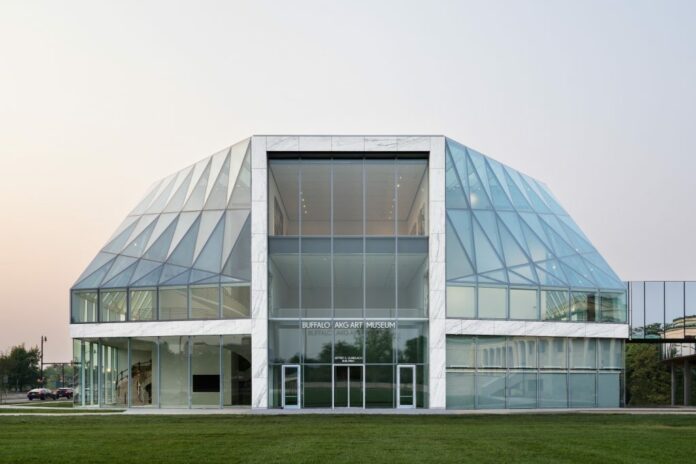Formerly the Albright Knox Art Gallery, the museum has opened to the public after a three-year renovation by OMA.

Can a museum truly become the heart of its community?
That is the ambitious question the new Buffalo AKG Art Museum, formerly the Albright Knox Art Gallery, has tried to answer with its recently unveiled renovation and expansion designed by Shohei Shigematsu of OMA in collaboration with Cooper Robertson. This past weekend, the much-anticipated new campus opened to the public, free of admission, reportedly drawing more than 11,000 visitors.
The project’s crowing achievement, the Jeffrey E. Gundlach Building—named after the Buffalo native who gave $65 million to the project—now sits on one side of the museum campus, a space befitting a world-class institution. The circular building, luminously veiled in glass, expands the museum’s exhibition space by some 30,000 square feet. This addition is currently finalizing essential construction and will officially open to the public on July 20.
In many ways, the remarkable financial investment in the museum is a testament to a percolating optimism in Buffalo and the belief that the makeover of this 161-year-old institution—the sixth oldest art museum in the U.S., in fact—will usher in a long-awaited renaissance for the industrial city that has seen its fair share of struggle.
Building Toward the Future
For Janne Sirén, the director of the Buffalo AKG who joined the museum in 2013, the renovation has always been about far more than a structural project, but a symbolic rebuilding of a relationship between the museum and its community. “As museums, we pride ourselves as custodians of great art and as champions of artists, these bravest of individuals,” said Sirén. “But sometimes the general public can feel a little unwelcome, which is something we wanted to address.”
To make this possible, the museum hosted a series of town halls and community meetings from the inception of the project, putting the public in conversation with museum leaders and, as the project progressed, with Shigematsu himself. When an early 2017 proposal met with pushback from locals, Shigematsu and the museum hit pause, revising the proposal to reflect these considerations.
In its final form, the building has an origami-like effect of both turning outward toward the city and pulling the city into the museum.
The grand staircase leading up to the museum’s original 1905 neoclassical building has been restored, offering an impressive invitation to entry. This marble staircase was removed during a 1962 renovation by American architect Gordon Bunshaft, and replaced with a parking lot. Here, OMA has moved parking underground and restored a large lawn at the heart of the museum campus, offering a green gathering place to the public, emphasizing the campus-like space, and placing the museum in more open conversation with the institutions it faces, including the Burchfield Penney Art Center and Buffalo State University.

The Ralph Wilson Town Square with Common Sky, 2022, by Olafur Eliasson and Sebastian Behmann of Studio Other Spaces, viewed from the southwest corner.
One of the most luminous and moving additions to the museum is Common Sky, a new site-specific commission by Olafur Eliasson and Sebastian Behmann of Studio Other Spaces in the Seymour H. Knox Building. The Knox Building was part of the 1962 Bunshaft addition and previously contained an open-air courtyard that was largely inaccessible to museum visitors, especially during Buffalo’s long winter months. Common Sky now encloses that courtyard, renamed the Ralph C. Wilson Town Square.
At once architectural and sculptural, Common Sky presents a canopy of glass and mirrors rendered in alternating triangular segments that allow the light to pour into the space below. Visitors can look up and see themselves reflected in the mirrors too, creating a synergistic and kaleidoscopic pushing and pulling of reflections and space. Common Sky’s form tapers into the courtyard itself, with a cyclone-shaped column that leads to a complex system of drains below. This asymmetrical element nods both to the location of a lone hawthorn tree planted in the original courtyard in the 1960s, while simultaneously serving as a drainage system of rain and snow that Buffalo is famed for.
During a press tour, it was impossible to ignore the lingering smoke in the air blown south from Canadian wildfires, and in that sense, the installation was a poetic and powerful encapsulation of our interconnected existence—a reflection on the shared experience of the sky.
“As an artwork, it sensitizes you to the world outside, to the surrounding environment of Buffalo. It draws your attention to things that are difficult to measure, to things that depend on emotion and on your active involvement,” said Eliasson.
A Storied Collection That’s Writing New Chapters
In many ways, Buffalo AKG’s renovation allows curators to showcase what it’s already had—a stellar permanent collection. Entering the museum’s main structure, the 1905 Neoclassical Wilbers building, the museum has for the first time been able to showcase a breadth of its storied holdings thanks to expanded gallery space.
Greeting visitors as they enter is Albert Bierstadt’s The Marina Piccola, Capri (1859), which was gifted to the museum by the artist when it opened in 1863. Pablo Picasso’s La Toilette (1906), another collection gem, is also on view, a nude so frank its acquisition scandalized the public, along with Giacomo Balla’s iconic Futurist work, (Dynamism of a Dog on a Leash) (1912).
The museum has particularly vast holdings of abstraction and here it dazzles. Jackson Pollock’s Convergence (1952) is so strikingly fresh-looking, one can imagine a hint of how audiences in the 1950s felt seeing his work for the first time. Joan Mitchell’s George Went Swimming at Barnes Hole, but It Got Too Cold (1957) is similarly awe-inducing. The largely chronological hang also includes top-tier works by Frida Kahlo, Romare Bearden, and Marisol, many other names familiar and those less so.

View of the Sculpture Court in the Wilmers Building with, from left to right, Aristide Maillol, La Nuit (Night) (1902–09); Morgan Russell, Synchromy in Orange: To Form (1913–14); Wilhelm Lehmbruck, Die Knieende (Kneeling Woman) (1911). Photo by Gregory Halpern.
For what is essentially a straightforward collection install, the effect is surprisingly revelatory—one realizes how rare it is to see best-in-class artworks together in one place. Here, there aren’t many slackers. That impression continues over in the Gundlach Building, where the curators look again toward their collection (the building was still under construction when I visited but the galleries were complete).
On the ground floor is “Clyfford Still: A Legacy for Buffalo,” curated by Cathleen Chaffee, the museum’s chief curator. The exhibition marks the first time in more than 15 years that the museum has shown its entire Still collection. It includes 33 paintings, 31 of which were gifted by the artist between 1937 to 1963, making it the second largest in the world after the Clyfford Still Museum’s collection.
These monumental abstractions are vivid encounters with color and texture, and underscore the museum’s dedicated relationships with artists; Still developed a friendship with the museum’s former director Gordon M. Smith and board president Seymour H. Knox, Jr. in the 1950s. Smith had offered Still his first museum-scale survey in 1959, giving the artist unprecedented control over its shape, eventually resulting in the donation of works.
Perhaps the most fun is the third floor of the Gundlach Building, which showcases Buffalo AKG’s newest acquisitions and includes works by Genesis Tremaine, Deborah Roberts, a great Martha Jungwirth, and a luminous Simone Forti hologram.

Installation view of “Clyfford Still: A Legacy for Buffalo” on the first floor of the Gundlach Building. Photo courtesy of Buffalo AKG Art Museum.
The installation hints at continuation rather than any sort of backward-looking sentiment, which feels accurate as the museum has certainly not lost its penchant for collecting. Since the construction began, the museum has rapidly expanded its holdings—in the past four years, it has added some 518 works to the collection, including 200 works by Pop art sculptor Marisol (Chaffee is organizing an expansive exhibition of the Venezuelan artist’s work, which will originate in Montreal before returning to the Buffalo AKG).
Leaving Buffalo, a chatty woman sat beside me on my flight. When I told her I was visiting to see the museum, she smiled. “We’re all so excited about it,” she said. “Buffalo is a blue-collar town with beer-drinking, football-loving, down-to-earth people. But we deserve a great museum too.”
Source: https://news.artnet.com/art-world/buffalo-akg-art-museum-2323983




